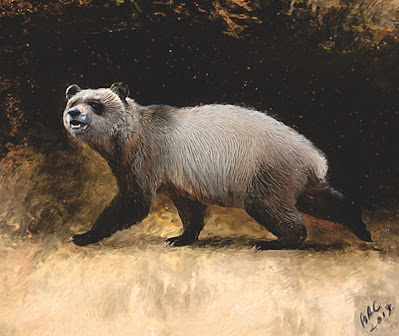 |
| ?Agriarctos nikolovi Jiangzuo & Spassov, 2022. Artwork by Velizar Simeonovski, Chicago. |
ABSTRACT
With advances in molecular phylogeny, the Ursidae affinity of Ailuropoda is no longer controversial. However, the early evolution of Ailuropoda and its close relatives (the tribe Ailuropodini) is still unclear. In this study, we describe a new fossil discovery from Bulgaria, which represents a new taxon of Ailuropodini, ?Agriarctos nikolovi. The materials of Ailurarctos are restudied and the evolution and dispersal of Ailuropodini are discussed. Early Ailuropodini split into two lineages, one in Europe as Agriarctos (three species, whose assignment to the same genus is not certain), and one in southeastern Asia as Ailurarctos and later Ailuropoda. Ailurarctos is a paraphyletic group, with both known species as successive direct ancestors to Ailuropoda. Subtribe Ailuropodina is proposed here to include Ailurarctos and Ailuropoda. Turolian European Agriarctos paralleled with Ailuropodina in many aspects, which reflects similar adaptation towards a specific herbivorous diet.
SYSTEMATIC PALEONTOLOGY
Order CARNIVORA Bowdich, 1821
Family URSIDAE Batsch, 1788
Subfamily AILUROPODINAE Grevé, 1892
Tribe AILUROPODINI Grevé, 1892
?AGRIARCTOS NIKOLOVI sp. nov.
Etymology— Named in honor of Dr. Ivan Nikolov, who has preserved the fossil teeth in the collections of the NMNHS and for his contributions to the study of the fossil mammal fauna of Bulgaria.
Age— Estimated late Messinian (i.e., latest Turolian) age (MN13).
Qigao Jiangzuo and Nikolai Spassov. 2022. A late Turolian Giant Panda from Bulgaria and the early Evolution and dispersal of the Panda Lineage. Journal of Vertebrate Paleontology. e2054718. DOI: 10.1080/02724634.2021.2054718
phys.org/news/2022-08-discovery-panda-species-europe.html
